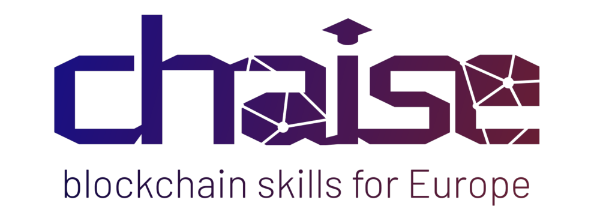Allkirjastage toetusavaldus CHAISE’ile
CHAISE (Blockchain Skills for Europe Alliance) kutsub organisatsioone allkirjastama avaldust, millega toetatakse projekti eesmärke ja tulemusi.
Mis on toetusavalduse eesmärk?
Toetusavaldus kutsub kõiki Euroopa plokiahela sidusrühmi, sealhulgas IT-ettevõtteid, sektori esindajaid, poliitikakujundajaid, sotsiaalpartnereid, standardiseerimisega tegelevaid organisatsioone, riiklikke kutsekvalifikatsiooniasutusi, kutse- ja kõrgharidusasutusi, koolitajaid/mentoreid ja valdkonna eksperte
- tunnustama uusi ametiprofiile plokiahela valdkonnas ning nende oskustele ja teadmistele kehtestatud nõudeid ning
- aitama kaasa projekti eesmärkide edendamisele, et tugevdada digipädevust tagavat haridust, lähtudes ühistest huvidest ning vastastikkuse kasu ja üksteise täiendamisest põhimõtetest.
CHAISE’i loodud plokiahela ametiprofiilid
CHAISE kasutas plokiahela sektori piiritlemiseks ja plokiahelaoskuste vahelise nõudmise ja pakkumise ning nendevaheliste ebakõlade määratlemiseks terviklikku ja uudset analüüsi, mis näitas, et Euroopa plokiahela valdkonnas on tekkimas kolm uut rolli (ametiprofiili): plokiahela arendaja, plokiahela arhitekt ja plokiahela juht. PLOKIAHELA ARENDAJA, PLOKIAHELA ARHITEKT, and PLOKIAHELA JUHT.
Plokiahela arendaja kodeerib plokiahela rakendusi ja hoolitseb probleemide lahendamise eest mikrotasandil. Selles ametis on vaja üldisi tarkvaraarendamise oskusi, kusjuures suurt rõhku pannakse plokiahela tehnoloogia ja rakenduste arendamise oskustele, ettevõtlusoskustele ja kõigile valdkonnaülestele tulevikuoskustele, eelkõige enesejuhtimisele.
Nõutavad oskused
- Tunneb ära valdkonnad, kus saab plokiahelat rakendada
- Tunneb plokiahela ja krüptorahaga seotud riske
- Oskab selgitada plokiahela tehnoloogia ja juhtimise mõju
- Tuvastab plokiahela tehnoloogiaga saavutatavad innovatsioonivõimalused
- Oskab selgitada plokiahelapõhist identiteedihaldust ja pääsu reguleerimist
- Oskab selgitada hajusraamatu tehnoloogia arhitektuuri põhimõtteid
- Oskab hinnata plokiahela arhitektuuri
- Uuendab plokiahela arhitektuuri
- Analüüsib detsentraliseeritud rakendusi
- Rakendab nutilepinguid
Nõutavad teadmised
- Plokiahela põhimõtted ja komponendid
- Plokiahela rakendused
- Plokiahela ajalugu
- Plokiahelapõhiste toodete ja teenuste õiguslik keskkond
- Plokiahela terminoloogia
- Plokiahela rakenduste turvalisuse põhimõtted
- Plokiahelapõhised ärimudelid
- Plokiahela rakendusvaldkonnad
- Teabe- ja andmeturbe põhimõtted
- Turvaaugud hajusraamatu tehnoloogias
- Digitaalidentiteedi haldamine
- Detsentraliseeritud identifikaatorid (DiD)
- Plokiahelapõhiste süsteemide projekteerimisprotsess
- Plokiahela projekteerimismustrid
- Hajusraamatu tehnoloogia konsensusprotokollid
- Nutilepingute programmeerimiskeel
- Mänguteooria
- Mänguteooria plokiahelas
Plokiahela arhitekt kavandab suuri plokiahela süsteeme ja tarkvaramaastiku mitmetasandilist arhitektuuri ning tagab projektide kõigi aspektide kui integreeritud süsteemi sidususe. Lisaks tagab plokiahela arhitekt plokiahela rakenduse üldise tehnilise kvaliteedi. Tema töö eeldab tugevat mikro- ja makrotasandi tunnetust. See keskendub eelkõige loominguliste projektide arendamisele toodete ja kasutusmallide kujundamisel, sealhulgas plokiahela lahenduste kontseptsiooni ja ülesehituse loomisele. Plokiahela arhitekti roll on võrreldav lahenduse arhitekti rolliga. Ta on IKT-süsteemide arhitekt, kes on spetsialiseerunud plokiahelapõhistele lahendustele. Tema ülesandeks on kavandada suuri plokiahela süsteeme ja tarkvaramaastiku mitmetasandilist arhitektuuri ning tagada projektide kõigi aspektide kui integreeritud süsteemi sidusus. Lisaks tagab plokiahela arhitekt plokiahela rakenduste üldise tehnilise kvaliteedi.
Nõutavad oskused
- Tunneb ära valdkonnad, kus saab plokiahelat rakendada
- Tunneb plokiahela ja krüptorahaga seotud riske
- Oskab selgitada plokiahela tehnoloogia ja juhtimise mõju
- Tuvastab plokiahela tehnoloogiaga saavutatavad innovatsioonivõimalused
- Oskab selgitada plokiahelapõhist identiteedihaldust ja pääsu reguleerimist
- Oskab selgitada hajusraamatu tehnoloogia arhitektuuri põhimõtteid
- Oskab hinnata plokiahela arhitektuuri
- Uuendab plokiahela arhitektuuri
- Rakendab krüptograafilisi konstruktsioone
- Analüüsib plokiahela kasutusmalle
- Suudab rakendusele plokiahela lisada
Nõutavad teadmised
- Plokiahela põhimõtted ja komponendid
- Plokiahela rakendused
- Plokiahela ajalugu
- Plokiahelapõhiste toodete ja teenuste õiguslik keskkond
- Plokiahela terminoloogia
- Plokiahela rakenduste turvalisuse põhimõtted
- Plokiahelapõhised ärimudelid
- Plokiahela rakendusvaldkonnad
- Teabe- ja andmeturbe põhimõtted
- Turvaaugud hajusraamatu tehnoloogias
- Digitaalidentiteedi haldamine
- Detsentraliseeritud identifikaatorid (DiD)
- Plokiahelapõhiste süsteemide projekteerimisprotsess
- Plokiahela projekteerimismustrid
- Hajusraamatu tehnoloogia konsensusprotokollid
- Plokiahela allkirjaskeemid
- Plokiahela kontseptsiooni rakendamine
Plokiahela juht juhib arendajate ja arhitektide töörühmi. Plokiahela juht jälgib rakendamise edenemist ja teeb tihedat koostööd ärijuhtide või turundusspetsialistidega, et teha kindlaks turunõuded uutele plokiahela süsteemidele ja rakendustele. Plokiahela juht jälgib protsessi kvaliteeti, millega tagatakse toodete vastavus nende tehnilistele ja ärilistele eesmärkidele, tutvustades muu hulgas tehnoloogia võimalike rakendusvaldkondade eetilisust. Tema töö hõlmab suhtlemist teiste sidusrühmadega, näiteks osakonnajuhatajate ja turundusspetsialistidega. Lisaks peab juht jälgima protsessi kvaliteeti, et tagada toodete vastavus nende tehnilistele ja ärilistele eesmärkidele, ning suhtlema muude sidusrühmadega, näiteks osakonnajuhatajate ja turundusspetsialistidega.
Nõutavad oskused
- Tunneb ära valdkonnad, kus saab plokiahelat rakendada
- Tunneb plokiahela ja krüptorahaga seotud riske
- Oskab selgitada plokiahela tehnoloogia ja juhtimise mõju
- Tuvastab plokiahela tehnoloogiaga saavutatavad innovatsioonivõimalused
- Oskab selgitada plokiahelapõhist identiteedihaldust ja pääsu reguleerimist
- Oskab selgitada hajusraamatu tehnoloogia arhitektuuri põhimõtteid
- Oskab hinnata plokiahela arhitektuuri
- Uuendab plokiahela arhitektuuri
- Rakendab krüptograafilisi konstruktsioone
- Analüüsib plokiahela kasutusmalle
- Suudab rakendusele plokiahela lisada
Nõutavad teadmised
- Plokiahela põhimõtted ja komponendid
- Plokiahela rakendused
- Plokiahela ajalugu
- Plokiahelapõhiste toodete ja teenuste õiguslik keskkond
- Plokiahela terminoloogia
- Plokiahela rakenduste turvalisuse põhimõtted
- Plokiahelapõhised ärimudelid
- Plokiahela rakendusvaldkonnad
- Teabe- ja andmeturbe põhimõtted
- Turvaaugud hajusraamatu tehnoloogias
- Digitaalidentiteedi haldamine
- Detsentraliseeritud identifikaatorid (DiD)
- Plokiahelapõhiste süsteemide projekteerimisprotsess
- Plokiahela projekteerimismustrid
- Hajusraamatu tehnoloogia konsensusprotokollid
- Plokiahela allkirjaskeemid
- Plokiahela kontseptsiooni rakendamine
CHAISE’i loodud plokiahelat tutvustav kutseharidusprogramm
CHAISE’i partnerid on koostanud kutsehariduse õppekava, et kompenseerida vajakajäämisi praeguse formaalse ja mitteformaalse õppe kvaliteedis seoses uute ametikohtadega plokiahela valdkonnas. Õppekava lähtub tööturu muutuvast vajadusest oskuste järele, mis on tekkinud seoses plokiahela kasutamismallide üha sagedasema kasutuselevõtuga kõigis majandussektorites.
CHAISE’i kutsehariduse õppekava koosneb esimesel õppeaastal kõigile kolmele plokiahela ametiprofiilile (arendaja, arhitekt ja juht) vajalikest ühistest moodulitest ning pärast teist õppeaastat keskendutakse spetsialiseerumist võimaldavatele õppeainetele. Programm kestab 5 semestrit ja vastab EQF 5-le.
Lisateavet leiate toetusavaldusest
Tunnusta CHAISE tulemusi ja anna märku oma toetusest!
Tulemuste tunnustamisega aitate kaasa plokiahela valdkonnas tegutsevate ametikohtade eri rollide ja võimaliku õppemeetodi selgemale kirjeldamisele, mis on ülekantav eri riikidele ja turgudele ning toetab ühiseid jõupingutusi, et rahuldada plokiahelasektori üha kasvavaid vajadusi.
Vormi saab täita siin!
